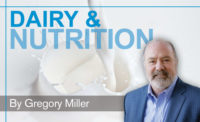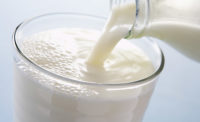Sustainability is at a higher awareness level, but consumers don’t necessarily call it that. People have broadened their interpretation of foods that are good for them beyond nutrition and health. For them it’s more about transparency and the greater good.
Why should this matter to the dairy community? Because consumers care about the peripheral view of their food choices, such as what’s in it, where did it come from, was it humanely raised and was there good stewardship of resources. They think about it in relation to their personal surroundings — the impact to my body, my family, my community and the planet.
The dairy community has an authentic, socially responsible story to tell when it comes to how dairy foods get from the farm to refrigerators, lunchrooms and dinner tables across America. Dairy farmers are longstanding stewards of the environment, continually improving their practices in the best interest of their cows, the land, people and the planet.
There is an opportunity for the dairy community to share this story in a way that will be relevant to the people who we want to feel good about (and purchase) dairy. First, we need to be on the same page when it comes to sustainable diets and food systems.
Sustainable food systems
Sustainable diets and food systems are an emerging field within the broader discipline of sustainability. Sustainable diets are at the intersection of agriculture, food production and nutrition. It is how foods contribute to social (e.g., nourishment, health, well-being), economic (e.g., affordable food, job creation) and environmental (e.g., reducing food waste and minimizing water, land and air impacts) outcomes.
Sustainability is about more than just the environment. It’s about how agriculture and nutrition must balance social, economic and environmental priorities. It’s the three-legged stool analogy – you need all three legs or the stool will fall over. And sustainability is the intersection of all three.
Dairy solutions to benefit health
The U.S. dairy community is helping underserved markets gain greater access to dairy products. They’re accelerating nutrition research and advancing the study of dairy’s role within sustainable food systems.
Dairy foods are fundamental to the healthy eating patterns recommended by the “Dietary Guidelines for Americans” (DGA), because of their significant nutrient contributions and link to reduced risk for chronic diseases.
Evidence links consumption of dairy foods with improved bone health, especially among children. Healthy eating patterns containing dairy foods are associated with reduced risk for cardiovascular disease and type 2 diabetes. This research is foundational to dairy’s contributions to sustainable food systems.
The role of the cow
The ability for the cow to be a recycler of feeds and forages and a nutrient-provider is part of what makes the cow’s role in agriculture so special. The uniqueness of the dairy cow should be shared as part of the sustainability story. Cows eat a balanced diet carefully planned by an animal nutritionist. Due to its distinct, four-chambered stomach, a cow can unlock nutrients from parts of plants people can’t eat, like almond and soybean hulls, orange peels, grasses, etc.
Therefore, those parts of foods are being converted into high-quality nutrition for people instead of going to landfills. It’s a win for the cow, the person and the environment.
Investment in science
The U.S. dairy community will invest in more science and collaborate with others to move forward on the following:
- Nourish with dairy. This means nourishing people, especially the food and nutrition insecure, by helping provide nutrient-rich, accessible and affordable dairy options. At the same time, minimize food loss and food waste across the supply chain to lessen the burden on the environment.
- Dairy drives food systems. This is ongoing research to understand the dairy cow’s contribution to food systems, human health, environmental resiliency and climate adaptation.
- Dairy is essential across all lifestyles. We will research to build the body of evidence for why dairy foods are hard to replace when it comes to nutrition, relevance and well-being. This will ultimately funnel into the dairy community’s efforts to better communicate dairy’s stories with greater relevance to consumers.
Ensuring dairy’s leadership
Sustainability, including sustainable diets and food systems, is a journey, not a destination. Science and insights will continue to drive the improvement and evolution of dairy’s role in sustainable food systems.
Understanding that sustainable food systems are complex, more than a carbon footprint, and about what is needed to sustain life amid climate change and global population growth is the first step on the journey to progress. We can continue to improve the availability, affordability and accessibility of nutrient-rich dairy foods.




